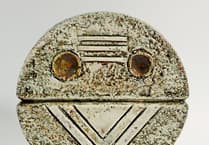THE number of boar on Forestry Commission land in the Dean declined by nearly a quarter over the last year.
But that could be because more of the animals are heading to towns and villages where food is easier to come by.
Research in Barcelona has shown two distinct groups of boar – those who hide away in the woods and those attracted to more urban areas – and we may be seeing the start of something similar here, according Deputy Surveyor of the Forest Kevin Stannard.
The annual thermal imaging survey taken in the spring indicates there are some 1,204 feral wild boar on the public forest estate, land owned by the Forestry Commission, compared with 1,500 in 2016, a decrease of 23 per cent.
The 23 per cent decrease in boar numbers suggested by the survey is closely mirrored by a 28 per cent drop in the number of road accidents involving the animals, the Forest Council’s scrutiny and overview committee heard.
Mr Stannard told councillors: “On the face of it we are finally getting to achieve the objective of stopping the upward trajectory and seeing population growth checked and be in a position to start bring the population in the Forest back down.”
But he said they would have to wait for the results of next year’s survey to see if the 2017 numbers are a “statistical blip”.
A researcher told a Forestry Commission workshop last summer that some of the highly intelligent animals may have cottoned on to the fact that there is more food in towns.
Mr Stannard said: “His research indicated there were almost two distinct populations of feral wild boar in Barcelona: those that were relatively small and secretive in the forest and those that had effectively become urban-
ised.
“We may be seeing the early signs of that – where some of the wild boar, and they are highly intelligent animals, are associating the communities with a better food source than in the forest.”
He said the only way to establish the facts would be to put radio collars on some of the boar and track their movements.
He also denied that shooting the boar deep in the Forest was driving them into areas more likely to bring them into conflict with humans.
He added: “If there was a clear link then we would be finding there were not enough animals to shoot and that is not the case.”
Although the number of complaints had decreased, he said that did not necessarily mean there were fewer boar.
He said: “The drop in complaints may be directly correlated to the apparent reduction in the number of boar but it may be due to other reasons such getting more familiar with them and more accepting of damage.”





Comments
This article has no comments yet. Be the first to leave a comment.